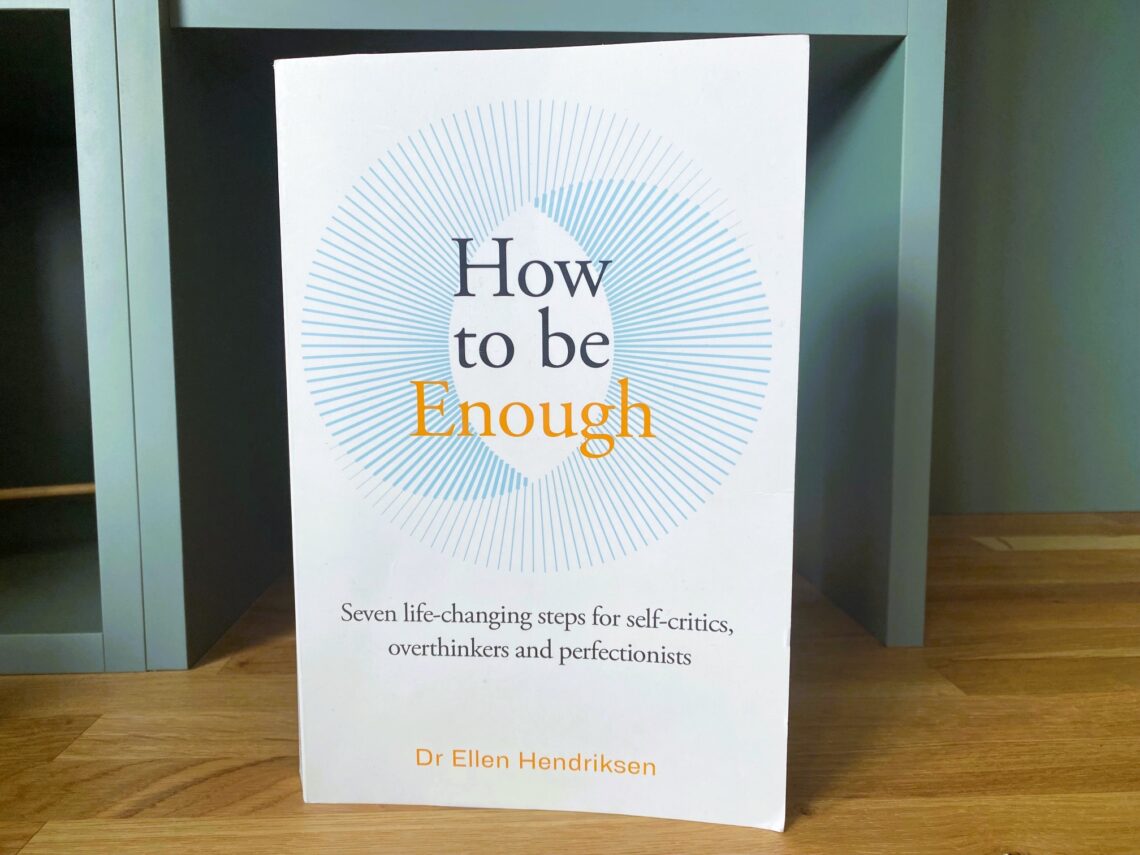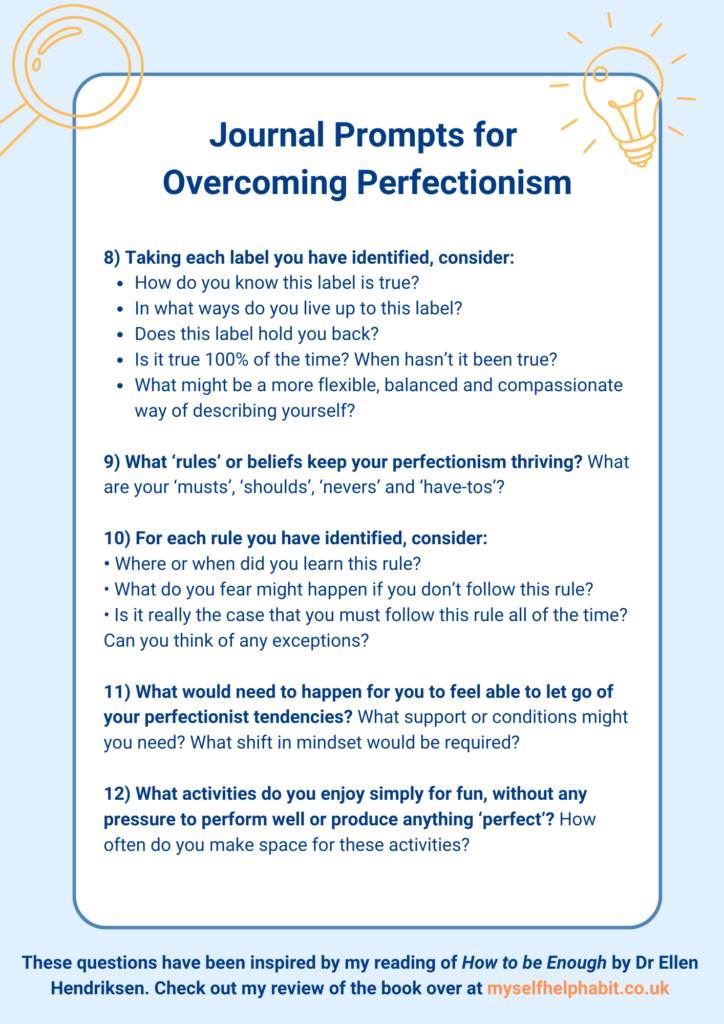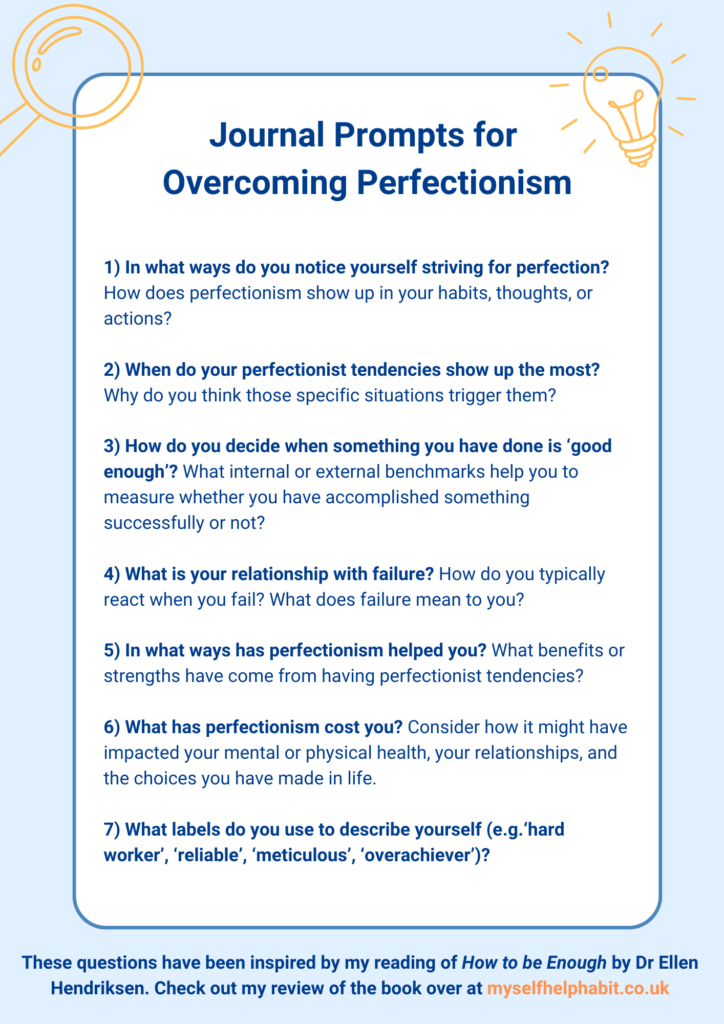
Is perfectionism plaguing you? Discover the root causes of perfectionism and how to overcome it!
Review of How to be Enough by Dr Ellen Hendriksen (2025, 320 pages)
Looking back, perfectionism has been the driving force behind so many of my actions! During my time at college and university, I would stay up into the early hours, meticulously refining every sentence in my assignment, poring over the copious notes I had compiled from textbooks, and making numerous revisions in an attempt to get everything ‘just right’. At work, it would often take me longer than necessary to get tasks done, because I would double and triple-check every detail, terrified of making the smallest mistake. It even affected the way I presented myself to others. I was keen to appear like I had my act firmly together, that I was calm, capable, and in control at all times. I wanted everyone to like and approve of me so, to escape their scrutiny and judgement, I avoided conflict and kept my feelings and opinions firmly to myself.
Only in recent years, after growing tired of the relentless pressure, the mental exhaustion, and the burden of concealing my struggles, did I begin to realise how much perfectionism was costing me. Slowly, I have started to dial it down. I’m growing more comfortable with sharing work that is unfinished, asking others for feedback, and deciding what my best looks like each day rather than putting pressure on myself to strive for 100% all of the time. I’ve also taken inspiration from those who have openly shared their insecurities, which has finally given me the courage to acknowledge and reveal my own.
That said, I am very much a recovering perfectionist! In all honesty, there is still a part of me that doesn’t want to let my standards drop and worries that I might be perceived as ‘sloppy’ or ‘lazy’ if I don’t put my all into everything I do. I still spend way too much time fretting over what people think of me and if my ideas and opinions will meet their approval.
So when the opportunity came to read and review, How to be Enough: Seven life-changing steps for self-critics, overthinkers and perfectionists*, I jumped at it! The author, Dr Ellen Hendriksen, is a self-confessed perfectionist and knows the traits of perfectionism extremely well, since she has recognised them in herself and in her work as a clinical psychologist and researcher.
Disclosure: I received a complimentary copy of How to be Good Enough from Bonnier Books. I am reviewing the book voluntarily.
*If you buy books linked to my site, I may earn a commission from Bookshop.org, whose fees support independent bookshops.
In her witty and engaging style, Hendriksen uncovers the roots of perfectionism and explains the different concepts associated with it. She introduces seven mindset shifts that are designed to loosen the grip that perfectionism has on our lives and foster greater self-acceptance. These shifts include practicing self-compassion, challenging our all-or-nothing thinking and rigid expectations, accepting our mistakes, reconnecting with our authentic selves, and deepening our connections with others.
Hendriksen also provides short, accessible exercises to help readers to address their own perfectionist tendencies. I particularly appreciated that she reminds the reader not to feel any pressure to ‘be perfect’ while completing the book’s activities. Acknowledging that this may show up for the reader was a really thoughtful touch!
If you’re curious about perfectionism, and want to explore its impact on your life, I invite you to reflect on the journal prompts below and keep on reading to discover my key takeaways from How to be Enough*.


What is perfectionism?
Perfectionism can be defined as ‘a hypercritical relationship with oneself’ (p.15) which leads us to set excessively high, and often unrealistic, standards for ourselves and sometimes for other people. Our whole sense of self-worth can rest on our ability to meet such standards. If they are not met we can become overly critical of ourselves or even defensive. For instance, a simple mistake might prompt us to label ourselves as ‘sloppy’ and ‘careless’, even if we have taken great care with our work, or we may try to save face and blame someone else for the error.
Perfectionism can also be ‘socially prescribed’ (p.93), arising from a fear of being judged by others or by the wider community if we do not meet the standards that are set for us. We therefore constantly seek acceptance and approval from others and desperately try to cover up our perceived flaws.
As Hendriksen points out, at the heart of perfectionism lies the belief that we are not good enough. Our underlying sense of inadequacy drives us to appear as if we are faultless and on top of everything. This striving can bring great rewards – we may perform exceptionally well at work, achieve impressive grades, and earn a reputation for being conscientious and reliable. However, underneath this veneer is a deep insecurity that we are worthless unless we are producing incredible results and pleasing others. It costs us precious time and energy to maintain this facade and such pressure can lead to stress, anxiety, social isolation, and burnout.
How to recognise perfectionism
Hendriksen explores the many ways in which perfectionism can show up in our lives. She highlights several common traits that indicate perfectionism, including:
- Harsh self-criticism – perfectionists often have a relentless inner critic. We can be incredibly unkind to ourselves when we fail to meet the standards and expectations that we hold ourselves to! We may tell ourselves that this inner voice keeps us humble and prevents any future mistakes (thereby saving us from the criticism and judgement of others). But the costs of listening to our inner critic all the time often results in more pressure and diminished self-confidence. When we are critical of ourselves, we can also become highly critical of the people around us, potentially damaging the relationships we have with others.
- Tying our self-worth to our performance – our identity and sense of value can become dependent on how well we, or others, feel we have performed. For example, if a presentation goes well, we see ourselves as capable and valuable. However, if it doesn’t, then we write ourselves off as being rubbish at public speaking and then spiral into self-doubt, thinking we’re incompetent and unworthy of our job.
- Rigid personal ‘rules’ – perfectionists often live by a strict set of internal ‘rules’ that dictate who they ‘should’ be and what they ‘should’ do. These rules are applied to all of their experiences, leaving no room for self-compassion or the nuances of different situations.
- Procrastination – putting off tasks is not always down to the fact that we simply can’t be bothered! If we dig deeper, we may find that we are trying to avoid uncomfortable feelings associated with the task and any negative consequences that may come from completing it. For instance, you might avoid posting on social media, making a whole load of excuses as to why you can’t do it, but really you’re afraid that the content won’t be ‘good enough’ and imagine that people will judge and criticise you.
- Constant comparison – when we get into the habit of comparing ourselves to others, and use that as a way to determine how well we are doing, we can come away feeling like we don’t measure up no matter what we do or achieve.
- Suppressing emotions – Perfectionists may be unwilling to acknowledge or express their true emotions and hide their feelings from others for fear of showing weakness or vulnerability.
- People-pleasing – A desire to gain acceptance and validation from others can lead us to put aside our needs and prioritise other people’s wishes and expectations instead.
- A deep fear of failure – We want to avoid the difficult feelings that failure brings and therefore only attempt tasks if we know the outcome is likely to be favourable or we spend an excessive amount of time on things in an attempt to create a successful outcome.
- Turning hobbies into obligations – we make an activity that we initially find fun and interesting into something onerous. I noticed this in myself after reading the book! I tend to turn anything I enjoy into something I feel I need to master, which piles on a load of pressure and takes away the fun!
What causes perfectionism?
Hendriksen explains that the roots of perfectionism are often formed in early childhood. She explores how anxious and critical parenting styles, combined with cultural influences and societal expectations, can foster perfectionist tendencies. This helps readers to discover the origins of their perfectionism and gain a better understanding of themselves.
Fundamentally, as human beings, we all crave safety and acceptance. Since belonging is vital to our survival, we want to do everything possible to avoid rejection. As we grow, we learn how to gain acceptance, approval, and praise from our caregivers and other authority figures in our lives. However, we may have to strive to get this acceptance and live up to impeccable standards, suppress ‘unacceptable’ emotions, perform to an exceptional level, or ‘toe the line’ and adhere to society’s expectations. If we fail to do so, we risk being ignored, harshly judged, or punished. This has a lasting impact since we internalise the beliefs that have been passed down to us and begin to see them on as our own.
How to overcome perfectionism
We don’t need to completely abandon the standards, values and qualities that have guided us towards success. We can still hold onto what Hendriksen describes as the ‘dream team of traits: conscientiousness, grit, commitment to excellence’ (p.23). The key is learning to identify the beliefs and behaviours that are unhelpful to us and that fuel our anxiety and self-judgement.
While there is no ‘quick fix’ for perfectionism, Hendriksen shares many strategies for managing it. Here are some the resonated with me:
Spot the labels and rules that are holding you back
Recognise the labels you’ve adopted, including those that are self-imposed and those that others have given to you. To identify your labels, Hendriksen recommends starting with the phrase ‘I am…’ (p.104) and then listing all the ways you would describe yourself. For example, ‘I am quiet’, ‘I am intelligent’, ‘I am sensible’, ‘I am disorganised’, etc. Notice how, for better or worse, these labels have become woven into your identity. Reflect on all the ways you currently live up to your labels and ask yourself: How does this label serve me? Is it empowering or does it hold me back?
Hendriksen also introduces readers to the concept of the Inner Rulebook. These are the rules that we have absorbed in childhood and continue to live by. These might sound like: ‘I should always be productive’, ‘Everyone must like me’, ‘I mustn’t make mistakes’, or ‘I shouldn’t draw attention to myself’.
To help uncover your own Inner Rulebook, Hendriksen suggests that you pay attention to thoughts that include the words, ‘should, always, never, have to, everyone, must’ (p.141). You can also spot rules in the judgements and criticisms you make, the activities you feel obliged to do, and the praise you offer to others. Hendriksen then encourages you to reflect on both the pros and cons of adhering to your rules.
While our rules and labels offer us a sense of consistency, predictability and control over our lives, we follow them so faithfully that we rarely ever stop to question their validity. They can become restrictive and heap a whole load of pressure on us to conform to unrealistic standards.
Identifying our labels and rules helps us to take steps to challenge them. We can then experiment with making choices that are more aligned with our goals and who we really want to be, rather than what our rules and labels dictate. For example, I used to live by the rule that ‘I must get everything right’. I therefore only ever wanted to show a polished and perfected version of my work. I was reluctant to let anyone see ‘the messy middle’, fearing that any critique would confirm a deeply held belief that ‘I’m not good enough’. However, this meant that I often missed out on valuable feedback! During my training in coaching and counselling skills, I had to get used to practising (and therefore messing up) in front of others and learn to receive constructive feedback. While this felt incredibly uncomfortable, over time, I realised that rather than proving that I wasn’t good enough, the feedback offered me different perspectives, helped me to reflect on my practice, and enabled me to become a better coach.
Challenge your ‘all-or-nothing’ thinking
We can easily get into the habit of thinking of ourselves and our experiences in rigid, absolute terms, which leaves no room for any exceptions or alternative explanations. For example, ‘I made a few typos in that report, I never get anything right’ or, one of my personal favourites, ‘I must have the right answers to hand whenever someone asks me a question’.
We can free ourselves from absolute thinking and adopt a more flexible approach instead. Notice when you slip into all-or-nothing thinking and try adjusting the language you use to describe yourself and others. For instance, I find it helpful to remind myself to replace statements that include the words ‘always’ or ‘never’ with ‘sometimes’. Give yourself time to question the beliefs that you consider to be absolute truths, and explore the grey areas that sit in-between any black and white thinking.
Hendriksen also stresses that we don’t have to reduce ourselves to a single definition or identity; we can hold multiple truths about ourselves. Using the prompts in the book, I was able to shift my mindset and remind myself that: ‘I am a conscientious person who sometimes makes mistakes’, ‘I am a smart person who sometimes doesn’t know the right answers’ and ‘I am a sensible person who can also be playful and young at heart!’
Embrace the fact that mistakes will happen!
Hendriksen urges us to ‘Let go again and again of the expectation that you never do anything embarrassing, stupid or wrong’ (pp.169-170).
We continually berate ourselves for making mistakes and appearing foolish, as we tend to personalise our failures, interpreting them as reflections of our character, which then creates feelings of guilt or shame. Such behaviour is rooted in our innate desire for acceptance and an underlying fear of rejection. We therefore go to great lengths to hide our flaws and avoid making errors. This might show up as constantly over-working to achieve some standard of perfection, avoiding new learning experiences to escape the discomfort of ‘conscious incompetence’, or procrastinating on a task to avoid potential criticism and judgement from others. However, the pressure to be flawless can be absolutely exhausting and pulls us away from other important aspects of life, like our own self-care and our personal relationships.
In addition, falling short of certain standards can awaken our inner critic, who gleefully reminds us of all the hiccups we have made (both past and present) in a misguided attempt to fix our flaws and shield us from rejection. While holding our hands up and taking some accountability when we have done wrong is important, we do not have to keep beating ourselves up.
If your inner critic tends to get the better of you whenever you slip up, Hendriksen provides a range of strategies to help you turn down that noisy and persistent inner voice:
- Shift from self-evaluation to the practical requirements of the task in hand. Instead of judging yourself, just focus on what specifically needs to be done differently. For example, rather than saying, ‘I’m such an idiot for missing out those details,’ you could say, ‘Next time, I will clarify what information needs to be recorded and set aside time each week to update my records.’
- Counter your inner critic’s harsh words and boost your confidence by reminding yourself of all the wonderful things that you know to be true about yourself. For example, ‘I am a caring and considerate person’, ‘I have a real passion for the work I do’, and ‘I love my unique sense of style’.
- Redefine your measures of success. Try adjusting your expectations of yourself and think of some less demanding ways to monitor your progress and performance.
- Adopt a growth mindset. Treat new activities as if they were experiments! Embrace the process of trial and error and be open to figuring things out as you go along. This can ease the burden of feeling like you have to get everything right first time and take some weight off your shoulders.
- Give yourself a break and make space for activities that are purely for fun (no targets or performance measures allowed!)
Open up to others
Before reading this book, I hadn’t fully realised how isolating perfectionism can be. Building friendships has always been a challenge for me, not just because I’m a major introvert, but also because I’ve been so preoccupied with maintaining a façade of composure and having everything firmly under control. This effort to conceal my troubles and imperfections, has actually distanced me from others and made true connection even harder.
Hendriksen stresses that opening up and disclosing more of our thoughts and feelings helps to build trust, promotes equality, and reminds us of our shared humanity. Rather than trying to impress others by masking our emotions and insecurities, Hendriksen recommends that we focus on deepening our relationships with others by sharing our challenges and vulnerabilities (as long as we are in a psychologically safe environment and it feels appropriate to do so!) As she points out, people are going to judge you anyway – whether you share things about yourself or not, so you might as well be authentic and focus on creating deeper connections with those who genuinely appreciate and accept you.
Focus on the things that are important and meaningful to you
As perfectionists, we try so hard to live up to everyone else’s expectations that we lose sight of our own needs and wishes. According to Hendriksen, constant people-pleasing eventually ‘renders us self-less’ (p.97). As much as we strive to be liked and accepted, she reminds us that we cannot please everyone. People will criticise and dislike us no matter what we do! If others only accept us because we agree with them and do everything they want us to do, we have to ask ourselves: are those relationships really worth our time and energy?
Instead of losing ourselves in the pursuit of pleasing others, Hendriksen encourages us to reclaim our ‘self-ness’. This means reconnecting with what is most important to you and determining your own priorities and principles. Tap into your values and goals and take actions that align with them, even if that requires you to say no to certain activities, turn down other people’s requests, and feel the discomfort that comes with setting boundaries.
It may also involve small acts of self-assertion, to get you into the habit of communicating your needs, desires and opinions. There are many ways you could do this, depending on what you find challenging. It might be stating what you would like to do on a day out, informing a member of staff when something is wrong with your meal at a restaurant, offering a different perspective in a meeting at work, or choosing clothes that you feel comfortable in, rather than worrying about what others might think.
How to be Enough* is a must read for anyone who is eager to understand why perfectionism is holding them back and wishes to learn practical strategies for managing its impact.
Hendriksen doesn’t offer readers an empty promise that they will be free of perfectionism by the end of the book. Instead, her message emphasises the vital role of acceptance. Getting things wrong, feeling awkward, and experiencing setbacks are all part of being human. Acceptance of this universal truth gives us permission to drop our facades and let go of the pretence that we are without fault. In fact, owning our struggles, and sharing our deepest thoughts and feelings, doesn’t isolate us from others, it brings us closer together.
We can even learn to live with our inner critic and see it for what it is – a scared, over-protective part of us, who is desperately trying to keep us safe. We can expect it to show up as we step out of our comfort zones and pursue our goals. Instead of believing every word it whispers into our ears, we can learn to acknowledge its presence, soothe it, and keep moving forward!
I think one of the most beautiful and relatable things about being human is that we don’t have everything figured out and nor are we supposed to! There’s something profoundly humbling in acknowledging that, no matter where we are in life, we are always learning and growing (and that’s perfectly OK!)




